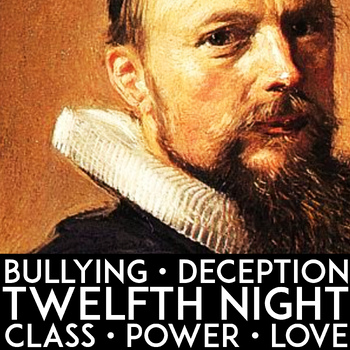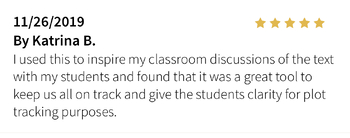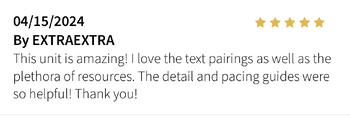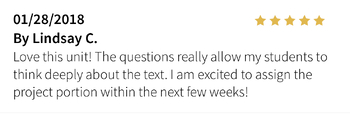Twelfth Night Bullying, Deception, & Love | Shakespeare Unit | Editable Handouts
- Zip
Description
Tired of students groaning and rolling their eyes whenever they hear the word “Shakespeare”?
Reading a Shakespeare play is challenging for students—but flashy handouts and cute classroom decor will not teach your students the skills they need to read, understand, or enjoy the Bard's work independently.
When students misbehave, put their heads on their desks, or just stare vacantly into the distance, it’s not because they aren’t capable of understanding the Bard—it’s because they are aren’t given the scaffolding and support they need to succeed. It’s no wonder that they act this way when they are made to feel incompetent and incapable by vague questions and inane activities.
With themes ranging from gender expression to modes of communication, drunkenness to deception, from bullying to love, and from abuse of power to the pursuit of greatness—Twelfth Night offers so much to explore.
But if you want your classes to get excited about reading this challenging text, your students will need to be excited to delve into the book and feel empowered to tackle the difficult language on their own.
You’ll also need to help your classes to make connections between their own lives and those of these fictional characters from so long ago.
When you follow the step-by-step methods that I outline here, your students will learn to understand the language and appreciate the artistry of the play and ultimately, to understand their own lives a little bit better.
The variety of materials, real-life connections, and innovative approaches to the essential questions of the text will keep students engaged and excited about learning. Additionally, the concrete text-based questions and unique sources discourage cheating and encourage students to answer for themselves.
The writing prompts, paired texts, and interactive notebook activities included in this resource have been honed over years of teaching this classic play.
When you teach your students to read, analyze, and enjoy Twelfth Night with this complete unit you will:
- Easily plan your 6-week unit when you utilize one of the two differentiated pacing guides for focusing on high-interest texts or standard or a literary analysis deep dive for honors and AP level classes.
- Get your students excited to start the play by engaging them in powerful pre-reading activities focusing on why we make bad decisions in groups, the metaphors we use to talk about love, and why we lie to ourselves and others.
- Start your class off with bellringer freewrite prompts that will help them to focus, get ready to work, and begin to explore the essential questions of the text.
- See a noted improvement in your students’ close reading skills and reading comprehension when they utilize the scaffolded, no-prep questions.
- Bring your students’ writing to the next level with daily prompts, essay questions, innovative creative writing assignments, and step-by-step writing instructions.
- Engage your most jaded students with the high-interest supplementary materials including a TED Talk, pop song analysis, poetry, and a short story.
- Edit the Student Handouts to best fit your needs and the needs of your classes with the fully editable document.
- Encourage your classes to go deeper in their analysis of the play with the extension activities focusing on Orsino's love metaphors, Viola’s speech, the fool’s songs, and Malvolio’s side of the story.
- Effortlessly discuss the play with your classes when you utilize the extensive answer keys which quote the important passages, so there is no guessing as to which parts of the text are most important.
- Give assessments that you are actually excited to grade such as a creative cooperative play, a literary analysis essay based on their own ideas, an accessible yet challenging final test, a creative poster project, or an original poem project.
- Easily grade cumulative and summative assessments with the multiple rubrics and answer keys.
Additional Texts and Sources Covered in this Resource:
“[When My Love Swears That She is Made of Truth]” by William Shakespeare
“A Certain Lady” by Dorothy Parker
Sonnets 18, 73, & 130 by William Shakespeare
“We Can Be Heroes” excerpt from the film Moulin Rouge
"A Better Way to Talk About Love” TED Talk by Mandy Len Catron
"The Man in the Well" by Ira Sher
***The following resources are included in this unit, all at a discount when you buy them together***
All-Purpose Handouts and Guides:
Close Reading Guide. Honed over 16 years of teaching high school English, including AP
literature, this guide is different because it explains the process in a way that actually makes sense to students—and teachers. The explanations and handouts included in this resource will help you and your classes make sense of the close reading process so that your students will be able to take the lessons learned and apply them to any text.
Reading Response Guide. This guide to reading response journals based on quote analysis and
close reading will get your students reading, analyzing, and writing about literature on their
own. I have been teaching with reading responses for eleven years, and this guide includes
what you need to teach your students to think independently without having to read and grade
every single thing they write.
High School Creative Writing for Literary Analysis | Fun Exercises & Activities. The fun creative writing exercises included in this resource will help your students analyze literature on a new level. The more often your students write on low-key and engaging prompts, the more comfortable they’ll be with writing
Writing Resources:
Modern Play Project. This fun, challenging, cooperative creative writing activity tasks students
to translate a portion of a Shakespeare play into contemporary English and a contemporary
situation and then perform their creation for the class. Because this Shakespeare activity
involves writing as well as paraphrase and analysis of the text, it is a great project for a
summative assessment. Additionally, this assignment encourages cooperative learning and
creativity. A bonus for overworked English teachers is that it gets students writing, but there
are fewer assignments to grade. You can view the full-priced version of this resource by clicking here.
48 Bellringer Prompts. When students write frequently in low-pressure situations, they see
writing as less of a big deal, and they feel more comfortable when they do have to write more formal essays. Additionally, when they know that they will be writing every day for a few
minutes, they less intimidated or anxious and are more likely to get right to work. And when
you have a prompt ready to go at the beginning of class, you’ll get a few calm, quiet minutes to
get through any business that you might have like taking attendance, passing back assignments,
or checking in with students individually. You can view the full-priced version of this resource by clicking here.
Supplementary Units
All of the following units include freewrite prompts and questions for close reading and
discussion.
“The Man in the Web” by Ira Sher. The short unit on “The Man in the Well” by Ira Sher will challenge your students to dig deep and think hard about what it takes to speak out against an immoral majority. It’s a very compelling and fairly horrifying story of a group of kids who, without even discussing it, decide to let a man die. With themes around dehumanization, how peer groups can influence for the worse, and how hard it is to speak up, this story gives plenty to discuss. You can view the full-priced version of this resource by clicking here.
Love and Lies Poetry: “[When My Love Swears That She is Made of Truth]” by William Shakespeare and “A Certain Lady” by Dorothy Parker (normally priced at $3.97). This short unit pairs a Shakespeare sonnet with a more modern poem. The included questions will get your students thinking about why we lie to ourselves and those we love. The ready-to-go handouts make the poems accessible, and the fun opener features the famous scenes of Lucy, Charley Brown, and the football. You can view the full-priced version of this resource by clicking here.
Fun Introduction to Shakespeare Sonnets Unit: Sonnets 18, 130, 73, & Love Songs. This innovative unit focuses on one main question: How do we talk about love? It’s a question that has been asked for centuries, and it is one that has never been fully answered, even by the greatest poets of all time. And yet, it is an important question to ask, especially for teenagers who are still struggling to define their world. As they work through different answers to that question in this engaging unit, your classes will analyze Shakespeare's Sonnet 18 "[Shall I compare thee to a summer’s day?]", Sonnet 130 ”[My mistress' eyes are nothing like the sun;]", and Sonnet 73 "[That time of year thou mayst in me behold]." Pairing those classic texts with contemporary TED Talks and pop culture, plus non-fiction primary source documents from the period will give your students a unique perspective on an age-old question. You can view the full-priced version of this resource by clicking here.
There are no lectures or power points here—students will do the work themselves, with guidance from their teacher. Rather than telling them what the play means, you will be empowering them with the confidence and skills to tackle a Shakespeare play on their own.





